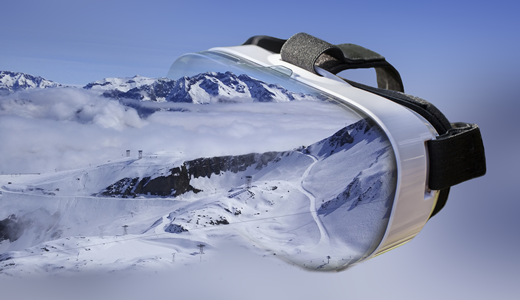If you’ve been watching any of the Winter Olympics, you’ve undoubtedly noted that, in some events, the difference between a winning run or a losing one can come down to mere seconds. No, sometimes just hundredths of a second. What you may not have been aware of, though, is that some of the competitors have been using video games to help them spruce up their medal-winning times.
For the last year, for instance, U.S. skiers—including yesterday’s giant slalom gold medalist Mikaela Shiffrin—have been strapping on virtual reality headsets and stepping up on balancing boards to help them mentally prepare for the various twists, turns, bumps and quick-cut gate positions of the South Korean slopes. Since the courses in the Taebaek mountains were the same ones used for past World Cup events, a U.S. recording team was able to ski the snowy hills in advance and grab 360-degree images for the teams VR practice runs.
In gaming vernacular, you could think of these virtual reality training runs as the skiers leveling themselves up to face the big boss. After all, there’s a great advantage to having visually traveled a course over and over, gaining a certain mental and motor awareness, as compared to those athletes who may have only had a couple runs on the actual slope before competition.
“The Olympics is the biggest event in an athlete’s life and it doesn’t take a genius to work out that skiing on a slope six times is not optimal time,” said Troy Taylor, the US Ski team high performance director, in a BBC Sport article. “The clear advantage of VR is that it is a great way to help athletes get more used to and learn specific courses, which is an obvious performance benefit. They feel they know the courses they will race on better, so when they come to ski on it during a race they enter the start gate with an increased confidence level.”
That, however, isn’t the only way that the Olympics and video games are intersecting. It turns out that a lot of people are suggesting, and in some cases pushing for gaming to become an Olympic competition by, say, the 2022 Bejing Winter games.
You giggle, but they’re really serious.
Think about it, e-sports (competitive gaming) is a $1.5 billion dollar industry where competitors rack in millions each year. It was reported by SuperData research that, in 2017, people around the world simply watched some 266 million hours of professional e-sports competition on the Twitch streaming service alone. Video gaming may not seem like much of a physical sport (or much of a watchable sport), but people just love to gaze at those seasoned oldsters of the gaming world—you know, those guys and gals in their 20s—whose fingers tap and fly across their keyboard in an amazing blur.
Oh, and don’t be fooled, these players go all out—in some cases working on their skillsets multiple hours a day with trainers, psychologists, and even nutritionists by their sides. “You need mental skill and physical skill. The physical skill is harder to see, but it’s there,” gamer Sean “Probe” Kempen, 21, of Australia, told Time. “The difference between a high-level player, and an extremely high level player, is mechanical skill,” he says. “Being quicker than your opponent makes a big difference.”
Now, I’ve never competed in e-sports, but I can tell you just from personal experience in some online competitive play, that even your run-of-the-mill multiplayer can be incredibly fast and dexterous. And when you get up to Kempen’s level, the hand-eye coordination and muscle memory is almost impossible to believe.
So don’t be surprised if some average-looking skinny kid is soon stepping up to the gold medal podium—with a personalized computer keyboard strapped to one hip and a Red Bull cup-holder on the other. Hey I’ve seen crazier things. Ever heard of curling?






Recent Comments